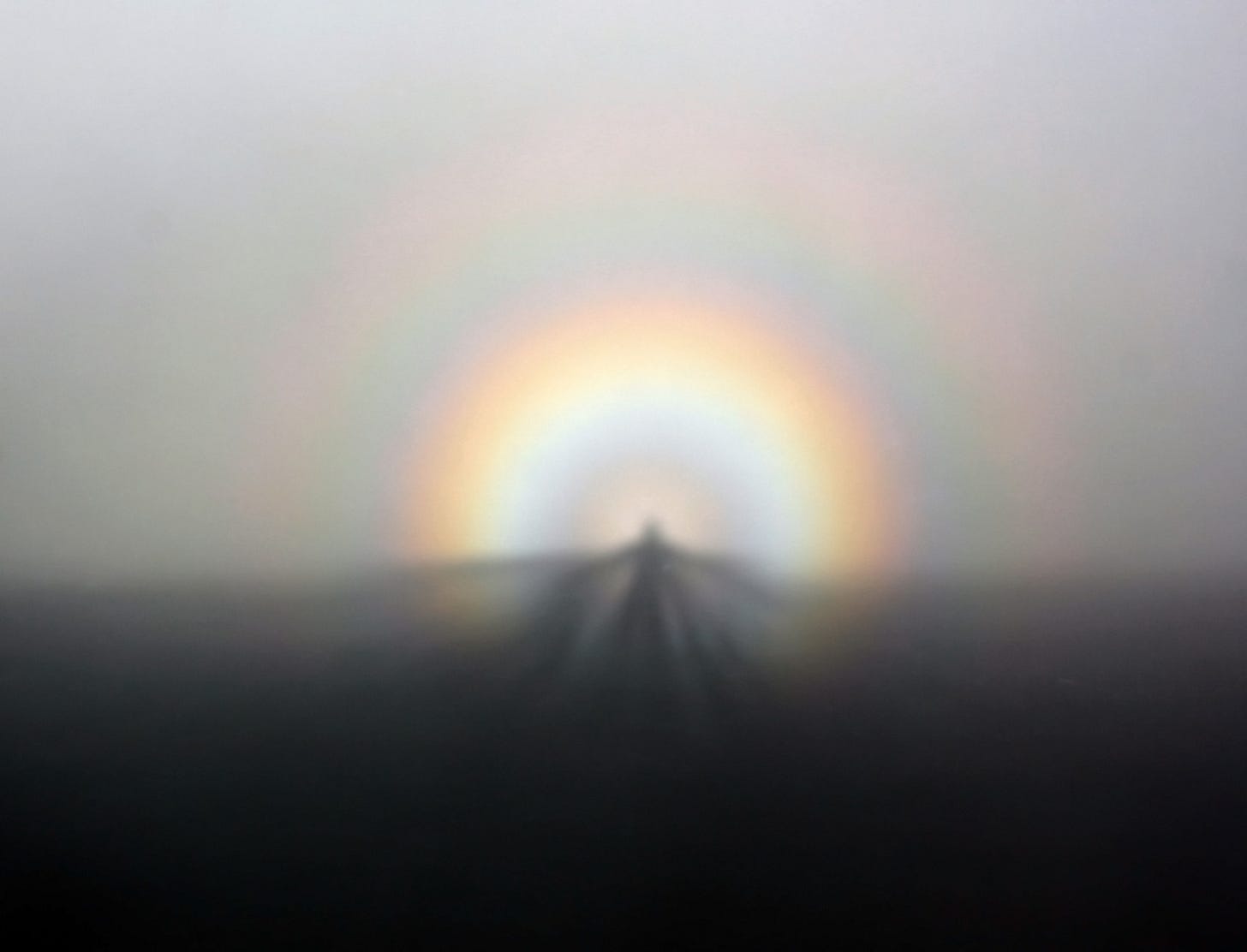Shadows in the Mist: The Enigmatic Beauty of the Brocken Spectre
Where folklore meets physics, a haunting optical marvel reveals how sunlight, mist, and elevation conjure illusions that once inspired fear and fascination
Image by Brocken Inaglory, CC BY-SA 3.0, https://commons.wikimedia.org/w/index.php?curid=15799557
High in the mountains, where the wind whispers through jagged rocks and fog hangs like a curtain across the landscape, a moment of eerie enchantment exists. A solitary climber, pausing at a mist-covered summit, may suddenly see an enormous ghostly figure looming within the cloud. Encircled by rainbow rings, the figure mimics the climber’s every movement. This strange apparition is not a supernatural entity, but a real and scientifically explainable event known as the Brocken Spectre.
Origins and Nomenclature
The name “Brocken Spectre” comes from the Brocken, the tallest peak in the Harz Mountains of central Germany. For centuries, the Brocken was associated with legends of witches and spirits, partly because of the frequent occurrence of this illusion. The phenomenon was first documented in the 18th century, but it likely captivated the imaginations of mountain dwellers and travellers long before that.
In German folklore, the appearance of the Brocken Spectre was considered an omen or a haunting. Today, it is recognised as a stunning natural interplay of light, shadow, and atmosphere.
The Science Behind the Spectacle
The Brocken Spectre is an optical illusion that depends on a precise alignment of environmental conditions:
The observer must be standing above the clouds or mist, typically on a ridge or mountain peak.
The sun must be low in the sky, usually behind the observer’s back.
The mist or cloud must be thick enough to reflect and scatter light, but not so dense as to obscure the shadow.
When sunlight hits the observer, it casts their shadow forward onto the fog or cloud bank below. Due to the distance and angle at which it is projected, the shadow appears greatly magnified, giving the illusion that it is larger than life.
Surrounding the shadow, glory rings may form. These are concentric circles of colored light created by the diffraction and backscattering of sunlight by water droplets in the mist. The rings resemble a miniature rainbow and are caused by processes similar to those that produce halos and coronas.
Psychological and Cultural Impressions
Witnesses of the Brocken Spectre often describe the experience as unnerving or profound. The phenomenon can feel deeply personal. After all, the shadow moves as the observer does, echoing their gestures in silence. In earlier times, such an experience might have been interpreted as a visitation from a spirit or a sign from another realm.
Writers, poets, and painters have referenced the Brocken Spectre in works dealing with isolation, introspection, and the sublime power of nature. The famous German writer Johann Wolfgang von Goethe reportedly saw the spectre during his ascent of the Brocken, and the imagery found its way into his poetry and prose.
Where and When It Occurs
Although it is named after the Brocken, the phenomenon is not limited to Germany. It can be observed from any high vantage point under the right conditions. Mountaineers in the Alps, hikers in the Scottish Highlands, and even pilots flying above cloud layers have reported seeing their own Brocken Spectres.
The best time to witness one is early morning or late afternoon when the sun is low and clouds are more likely to form below mountain peaks. Those who seek it should be ready with a camera and patience, though nature does not always reward on command.
A Modern Fascination
In the age of smartphones and social media, the Brocken Spectre has found new fame. Photos of the phenomenon continue to circulate, mesmerising people across the world. It is a reminder that some of the most incredible experiences still come not from artificial effects but from simply standing in the right place at the right time.
Beyond its photogenic appeal, it serves as a metaphor. The Brocken Spectre reflects the idea that the most haunting shadows are often our own, and the beauty we seek outside ourselves may be shaped by the light we carry within.
Conclusion: Nature’s Ghost in the Clouds
The Brocken Spectre is one of those rare moments where science, mystery, and art intersect. It teaches us that natural phenomena need not be exotic or far away to inspire awe. Sometimes, all it takes is a mountain, a mist, and a bit of sunlight to reveal a spectre that has always been part of us.
Whether you call it a shadow, a reflection, or a vision, the Brocken Spectre is a striking example of how nature continues to surprise and enchant those who are willing to look closely and believe in the unseen.
As always, feel free to reach out with any questions or comments. Happy musing!


